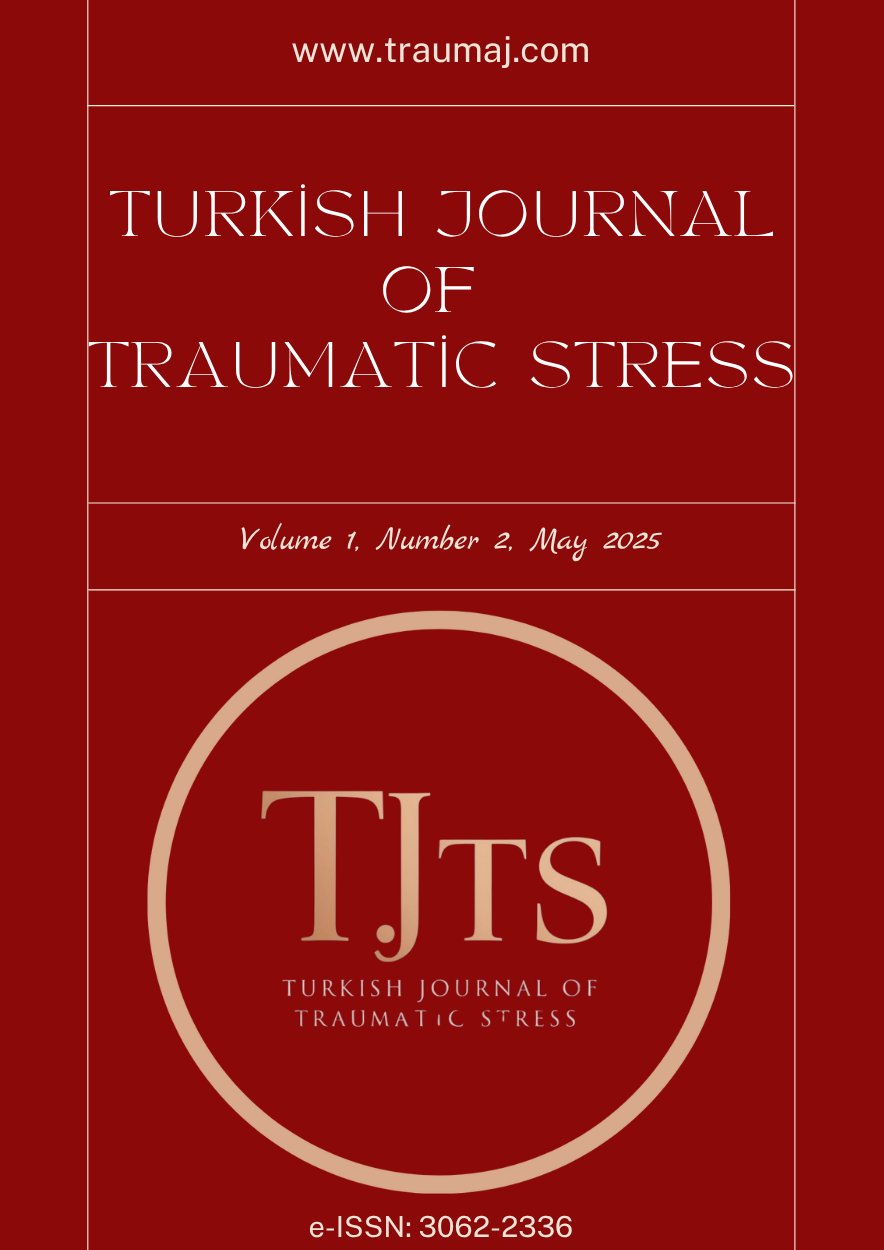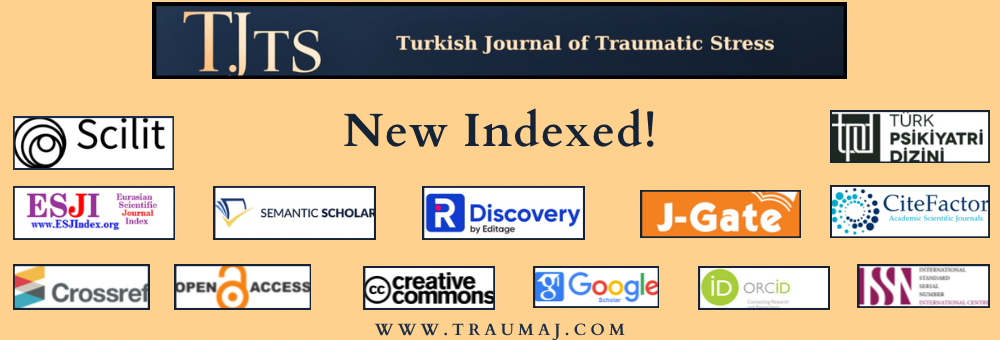A Single-Session Flash Technique Group Intervention to Reduce Secondary Traumatic Stress Among Mental Health Workers in Earthquake-Affected Areas
A Single-Session Flash Technique Group Intervention for Mental Health Workers
DOI:
https://doi.org/10.63175/tjts.17Keywords:
EMDR, earthquake, Flash Technique, Traumatic Stress, Group-based intervention, Secondary Traumatic StressAbstract
Background: Following natural disasters that cause mass trauma, health professionals and aid workers working in the disaster area may experience increased secondary traumatic stress and burnout due to being exposed to the traumatic experiences of others, which may lead to a decrease in both their mental health and professional functions. In this study, the effectiveness of a single-session Eye Movement Desensitization and Reprocessing (EMDR) Flash Technique group intervention implemented to reduce the traumatic stress levels of professionals working in the Kahramanmaraş-centered earthquake zone was evaluated.
Methods: The study was conducted with a total of 13 trauma workers (X̄age=27.8±2.1) working in container cities in Malatya and Adıyaman. A 90-minute Flash group protocol was applied. Before and after the intervention, participants’ distress intensity regarding traumatic scenes was measured using Subjective Units of Distress (SUD) scores.
Results: The mean and standard deviations of the SUD scores given by the participants to each of the three traumatic events they selected at the beginning of the session Incident-1=8.7±1.1, Incident-2=7.5±1.2, Incident-3=6.2±1.3 decreased significantly at the end of the session (0.38±0.50, 0.15±0.37, 0.07±0.27, respectively). All participants stated verbal expressions of positive changes such as a sense of relief, emotional distancing and relaxation at the end of the session.
Conclusion: This study shows that the EMDR Flash Technique can be an effective method in reducing secondary traumatization symptoms in professionals working in earthquake zones. Being able to apply it quickly and in groups increases the usability of this technique in post-disaster psychological support processes.
This article’s short podcast by AI (English)
This article’s short podcast by AI (Turkish)
References
1. Kroll A, Remington CL, Awasthi P, Ganapati NE. Mitigating the negative effects of emotional labor: A study of disaster response and recovery workers after the 2010 Haiti earthquake. Governance. 2021;34(1):87-106. https://doi.org/10.1111/gove.12476
2. Marangoz M, İzci Ç. Evaluation of the Economic, Social and Environmental Impacts of Natural Disasters on Entrepreneurs in the Context of the February 6, 2023 Kahramanmaraş Centered Earthquakes. The Journal of Social and Human Sciences Research- SOBBİAD. 2023; 24(52):1-30.
3. Çelik MA, Bayram H, Özüpekçe S. An assessment on climatological, meteorological and hydrological disasters that occurred in Turkey in the last 30 years (1987-2017). International Journal of Geography and Geography Education, 2018; 38, 295-310. https://doi.org/10.32003/iggei.424675
4. Kandilli Observatory and Earthquake Research Institute. 6 Şubat 2023 Kahramanmaraş Depremleri Raporu. Bogazici University; 2023. Accessed May 18, 2025. http://koeri.boun.edu.tr/new/sites/default/files/KRDAE-2023-Deprem-On-Degerlendirme-Raporu.pdf
5. Demir A, Celebi E, Ozturk H, et al. Destructive impact of successive high magnitude earthquakes occurred in Türkiye’s Kahramanmaraş on February 6, 2023. Bull Earthquake Eng 2025; 23, 893–919. https://doi.org/10.1007/s10518-024-01865-5
6. Presidency of Turkey, Presidency of Strategy and Budget. 2023 Kahramanmaraş and Hatay Earthquakes Report. Accessed May 18, 2025. https://www.sbb.gov.tr/wp-content/uploads/2023/03/2023-Kahramanmaras-and-Hatay-Earthquakes-Report.pdf
7. Nemutlu ÖF, Sarı A, Balun B. Comparison of Actual Loss of Life and Structural Damage in 06 February 2023 Kahramanmaraş Earthquakes (Mw 7.7-Mw 7.6) with Estimated Values AKU J. Sci. Eng. 2023; 23(5):1222-1234. https://doi.org/10.35414/akufemubid.130225
8. American Psychiatric Association. Diagnostic and Statistical Manual of Mental Disorders. 5th ed. American Psychiatric Publishing; 2013.
9. Norris FH, ed. Methods for Disaster Mental Health Research. Guilford Press; 2006.
10. Kahil A, Palabıyıkoğlu NR. Secondary Traumatic Stress. Current Approaches in Psychiatry. 2018;10(1):59-70. https://doi.org/10.18863/pgy.336495
11. McCann IL, Pearlman LA. Vicarious traumatization: a framework for understanding the psychological effects of working with victims. J Trauma Stress. 1990;3(1):131-149.
12. Gülyol Y. An Overview of Earthquake-Induced Secondary Traumatic Stress. HABITUS Journal of Sociology. 2024;5(5):37-60. https://doi.org/10.62156/habitus.1412564
13. Bıçakçı AB, Okumuş FEE. Psychological Impact of The Earthquake and Aid Workers. 2023;14(1):206-236.
14. Rauvola RS, Vega DM, Lavigne KN. Compassion fatigue, secondary traumatic stress, and vicarious traumatization: A qualitative review and research agenda. Occupational Health Science. 2019;3:297-336.
15. Bride BE. Prevalence of secondary traumatic stress among social workers. Soc Work. 2007;52(1):63-70. doi:10.1093/sw/52.1.63
16. Maslach C, Jackson SE. Burnout in health professions: a social psychological analysis. In: Social Psychology of Health and Illness. Psychology Press; 2013:227-251.
17. Hureau DM, Wilson T, Rivera-Cuadrado W, Papachristos AV. The experience of secondary traumatic stress among community violence interventionists in Chicago. Prev Med. 2022;165:107186. https://doi.org/10.1016/j.ypmed.2022.10718
18. Mangoulia P, Koukia E, Alevizopoulos G, Fildissis G, Katostaras T. Prevalence of secondary traumatic stress among psychiatric nurses in Greece. Arch Psychiatr Nurs. 2015;29(5):333-338. doi:10.1016/j.apnu.2015.06.001
19. Birinci GG, Erden H. Evaluation of vicarious trauma, secondary traumatic stress and burnout in aid workers. Turkish Journal of Psychology. 2016;31(77).
20. Aydin A, Ozturk E. Examining the association of childhood trauma with secondary traumatic stress for employees working in penal institutions. Eur J Trauma Dissociation. 2025;9(1):100507. doi:10.1016/j.ejtd.2025.100507
21. World Health Organization. Guidelines for the Management of Conditions That Are Specifically Related to Stress. WHO; 2013.
22. Silver KE, Levant RF. An appraisal of the American Psychological Association’s clinical practice guideline for the treatment of posttraumatic stress disorder. Psychotherapy (Chic). 2019;56(3):347 https://doi.org/10.1037/pst0000230
23. Shapiro E. EMDR and early psychological intervention following trauma. Eur Rev Appl Psychol. 2012;62(4):241-251. doi:10.1016/j.erap.2012.09.003
24. Hase M, Balmaceda UM, Ostacoli L, Liebermann P, Hofmann A. The AIP model of EMDR therapy and pathogenic memories. Front Psychol. 2017;8:1578. doi:10.3389/fpsyg.2017.01578
25. Solomon RM, Shapiro F. EMDR and the adaptive information processing model: potential mechanisms of change. J EMDR Pract Res. 2008;2(4):315-325. https://doi.org/10.1891/1933-3196.2.4.315
26. Solomon R, Oren E. EMDR therapy: An overview of its development and mechanisms of action. Eur Rev Appl Psychol. 2012;62(4):197-203. https://doi.org/10.1016/j.erap.2012.08.005
27. Oren E, Gündoğmuş İ, Yaşar AB. EMDR and the AIP model: healing the scars of trauma. Front Psychiatry. 2024;15:1469787. doi:10.3389/fpsyt.2024.1469787
28. Maxfield L, Hyer L. The relationship between efficacy and methodology in studies investigating EMDR treatment of PTSD. J Clin Psychol. 2002;58(1):23-41. doi:10.1002/jclp.1127
29. Manfield PE, Taylor G, Dornbush E, Engel L, Greenwald R. Preliminary evidence for the acceptability, safety, and efficacy of the flash technique. Front Psychiatry. 2024;14:1273704. doi:10.3389/fpsyt.2023.1273704
30. Manfield P, Lovett J, Engel L, Manfield D. Use of the flash technique in EMDR therapy: four case examples. J EMDR Pract Res. 2017;11(4):195-205. doi:10.1891/1933-3196.11.4.195
31. Manfield P, Engel L. Group flash technique. In: Luber M, ed. EMDR Group Therapy: Emerging Principles and Protocols to Treat Trauma and Beyond. Springer; 2023:115.
32. Manfield PE, Engel L, Greenwald R, Bullard DG. Flash technique in a scalable low-intensity group intervention for COVID-19-related stress in healthcare providers. J EMDR Pract Res. 2021;15(2):127-139. doi:10.1891/EMDR-D-20-00053
33. Wong SL. Flash technique group protocol for highly dissociative clients in a homeless shelter: a clinical report. J EMDR Pract Res. 2019;13(1):20-29. doi:10.1891/1933-3196.13.1.20
34. Yaşar AB, Gündoğmuş İ, Gündüz A, Konuk E. The effects of single session EMDR FLASH technique group application on traumatic symptoms. Israel J Psychiatry. 2021;58(2):41-46.
35. Yaşar AB, Konuk E, Kavakçı Ö, Uygun E, Gündoğmuş İ, Taygar AS, Uludağ E. Symptoms, depression, anxiety, stress, and life of quality with individuals who have experienced a traffic accident. Front Psychol. 2022;13:845481. https://doi.org/10.3389/fpsyg.2022.845481
36. Avcı M. Investigation Of The Single Session Effect Of Flash Technique On Adolescents With Exam Anxiety: A Group Practice. Uluslararası Anadolu Sosyal Bilimler Dergisi. 2023;7(1):222-231.
37. Avcı M. The effect of the flash technique on childhood traumas, dissociation, and post-traumatic stress symptoms: six case series. Int J Health Sci. 2023;11(1):102-112.
38. Alting van Geusau VV, de Jongh A, Nuijs MD, Brouwers TC, Moerbeek M, Matthijssen SJ. The effectiveness, efficiency, and acceptability of EMDR vs EMDR 2.0 vs the Flash technique in the treatment of patients with PTSD: study protocol for the ENHANCE randomized controlled trial. Front Psychiatry. 2023;14:1278052. doi:10.3389/fpsyt.2023.1278052
39. Matthijssen SJMA, van Schie K, van den Hout MA. The effect of modality specific interference on working memory in recalling aversive auditory and visual memories. Cogn Emot. 2019;33(6):1169-1180. doi:10.1080/02699931.2018.1547271
Published
How to Cite
Issue
Section
License
Copyright (c) 2025 Çiğdem Kınık, Canan Tütünen, Beyza Erdin

This work is licensed under a Creative Commons Attribution 4.0 International License.








